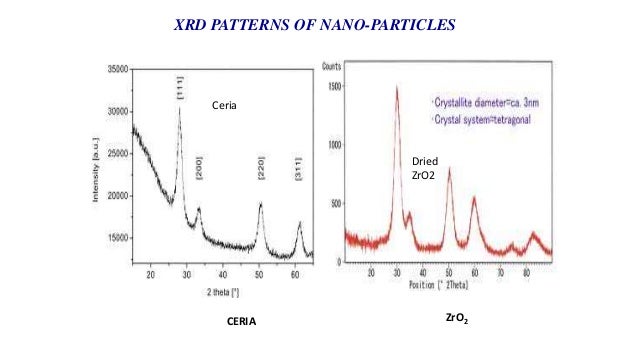Xrd Technique Download
« Previous | Next »
Session Overview
FREE PDXL UPGRADES ARE AVAILABLE ON-LINE FOR THOSE WITH RECENT VERSIONS. KEEP YOUR LICENSED COPIES UP TO DATE 1. To download the newest version, go to your PDXL help menu, click on “ Update PDXL”. If your computer is hooked to the internet, the following window. Applications of XRD The electron density and accordingly, the position of the atoms in complex structures, such as penicillin may be determined from a comprehensive mathematical study of the x-ray diffraction pattern. The elucidation of structure of penicillin by xrd paved the way for the later synthesis of penicillin. The powder xrd pattern.
Download the Aeris Research data sheet here. In this short video we explain how you can use X-ray diffraction (XRD). (XRF) is an analytical technique that can be used to determine the.
| Modules | Crystalline Materials |
| Concepts | Braggs' law, x-ray diffraction of crystals: diffractometry, Laue, and Debye-Scherrer, crystal symmetry and selection rules |
| Keywords | x-ray diffraction, Braggs’ law, angle of incidence, angle of reflection, constructive interference, destructive interference, crest, trough, amplitude, wavelength, phase, monochromatic, coherent light, incoherent light, order of reflection, index of refraction, collimator, diffraction peak, rotational symmetry, Laue diffraction, quasicrystal, translational symmetry, long-range order, x-ray crystallography, Penrose tiles, William Henry Bragg, William Lawrence Bragg, Max von Laue, Roger Penrose, Peter Debye, Peter Scherrer, Dan Shechtman |
| Chemical Substances | copper (Cu), nickel (Ni), silicon (Si), aluminum-manganese alloy (Al-Mn) |
| Applications | growth of single-crystal Si, identification of planes and symmetry in crystals, Penrose tiles |
Prerequisites
Before starting this session, you should be familiar with the prior topics in this module (Session 15 through Session 17), especially:
- Miller indices for crystal directions and planes
- SC, FCC, and BCC crystal structures
- X-ray production methods and characteristic emission lines (Cu Kα, etc.)
Looking Ahead
X-ray diffraction is a popular technique to discover the structures of organic molecules such as proteins (Session 31) and, most famously, DNA (Session 32), as well as inorganic crystals. It is also used to determine the degree of long-range order and symmetry present in a crystal, or lacking in a glass, which is the topic of the next module (Session 21: Introduction to Glasses).
Learning Objectives
After completing this session, you should be able to:
- Sketch the reflection of incident radiation off atomic planes, and derive Braggs' law for this geometry.
- Identify which planes produce x-ray diffraction peaks in FCC and BCC crystals.
- Given a graph of x-ray intensity vs. angle, or the 2θ values of the diffraction peaks, determine the crystal structure and lattice constant of the sample.
- Explain the difference between x-ray diffractometry and Laue diffraction.
- Determine the types of symmetry present in a given tiling pattern.
Reading
Archived Lecture Notes #5 (PDF), Sections 4-6
| Book Chapters | Topics |
|---|---|
| [Saylor] 12.3, 'Structures of Simple Binary Compounds.' | Common structures of binary compounds, x-ray diffraction |
| [JS] 3.7, 'X-Ray Diffraction.' | Diffraction, Braggs' law and reflection rules; single-crystal, polycrystal, and powder diffraction techniques |
Lecture Video
Flash and JavaScript are required for this feature.
Resources
Lecture Summary
X-rays reflect off each atomic plane in a crystal, producing patterns of destructive and constructive interference according to Braggs' law. One popular method of determining crystal structure, x-ray diffractometry, involves monochromatic x-rays bouncing off a rotating target; the resulting peaks indicate the identity and spacing of the close-packed planes, which are different for FCC and BCC. Another method, Laue diffraction, uses x-rays of multiple wavelengths and a fixed target, producing a pattern reflective of the symmetry present in the crystal structure. The cubic lattices include planes that have 1, 2, 3, or 4-fold rotational symmetry, but quasicrystals displaying 5-fold structures have been observed in experiments on Al-Mn alloys and generated mathematically as Penrose tiles.
Homework
Textbook Problems
[JS] Chapter 3, Sample Problems 20, 21

| [Saylor] Sections | Conceptual | Numerical |
|---|---|---|
| [Saylor] 12.3, 'Structures of Simple Binary Compounds.' | 8, 9 | 11, 12 |
For Further Study
People
William Henry Bragg, William Lawrence Bragg – 1915 Nobel Prize in Physics
Max von Laue – 1914 Nobel Prize in Physics
Peter Debye – 1936 Nobel Prize in Chemistry
Culture
Mozart, Wolfgang. 'Rondo Alla Turca.' Piano Sonata no. 11 in A major, K. 331.
Other OCW and OER Content
| Content | Provider | Level | Notes |
|---|---|---|---|
| X-Ray Diffraction Techniques | DoITPoMS | Undergraduate |
« Previous | Next »
Welcome!
This is one of over 2,200 courses on OCW. Find materials for this course in the pages linked along the left.
MIT OpenCourseWare is a free & open publication of material from thousands of MIT courses, covering the entire MIT curriculum.
No enrollment or registration. Freely browse and use OCW materials at your own pace. There's no signup, and no start or end dates.
Xrd Technique Download Youtube
Knowledge is your reward. Use OCW to guide your own life-long learning, or to teach others. We don't offer credit or certification for using OCW.
Made for sharing. Download files for later. Send to friends and colleagues. Modify, remix, and reuse (just remember to cite OCW as the source.)
Xrd Technique Download Free
Learn more at Get Started with MIT OpenCourseWare